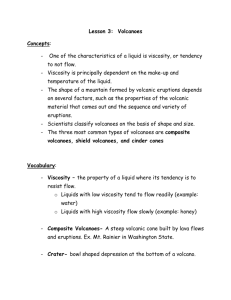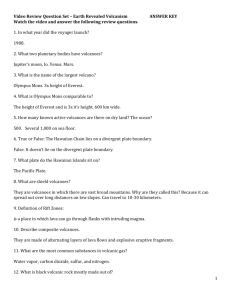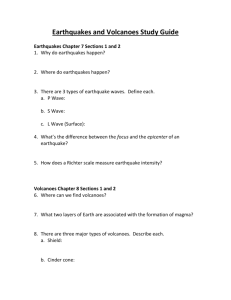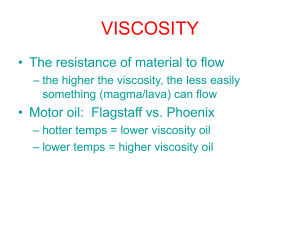Volcanic Eruptions: Earth Science Worksheet
advertisement
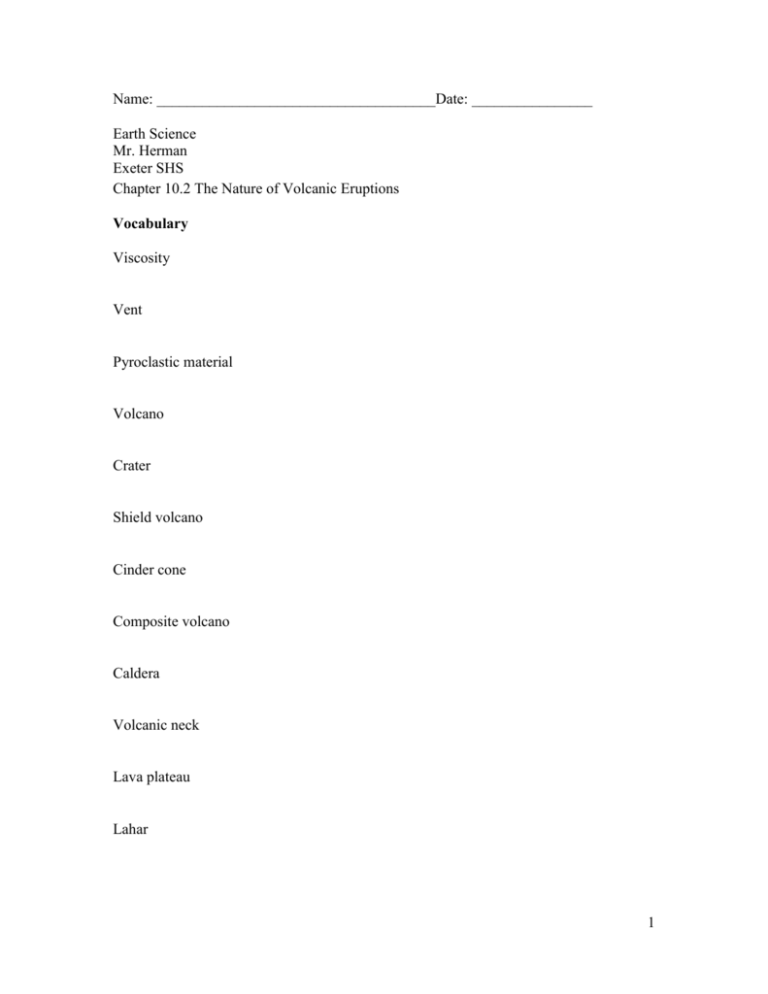
Name: _____________________________________Date: ________________ Earth Science Mr. Herman Exeter SHS Chapter 10.2 The Nature of Volcanic Eruptions Vocabulary Viscosity Vent Pyroclastic material Volcano Crater Shield volcano Cinder cone Composite volcano Caldera Volcanic neck Lava plateau Lahar 1 Objectives: Explain the factors that determine the type of volcanic eruptions that occur. Describe the various types of volcanic materials that are ejected from volcanoes. List the three main types of volcanoes. Distinguish how the different types of volcanic landforms forms. Factors Affecting Eruptions Factors that determine the violence of an eruption Composition of the magma Temperature of the magma Dissolved gases in the magma Viscosity Viscosity is the measure of a material's resistance to flow. Viscosity Factors affecting viscosity Temperature (hotter magmas are less viscous) Composition (silica content) High silica—high viscosity (e.g., rhyolitic lava) Intermediate silica – intermediate viscosity (e.g. andesitic lava) Low silica—more fluid (e.g., basaltic lava) Dissolved gases Mainly water vapor and carbon dioxide Gases expand near the surface A vent is an opening in the surface of Earth through which molten rock and gases are released. Provide the force to extrude lava Violence of an eruption is related to how easily gases escape from magma- Gases escape easily from fluid magma. Viscous magma produces a more violent eruption. 2 Volcanic Material Lava Flows Basaltic lavas are more fluid. Types of Lava Pahoehoe lava (resembles braids in ropes) Aa lava (rough, jagged blocks) Gases One to 5 percent of magma by weight Mainly water vapor and carbon dioxide Rope lava (Pahoehoe) 3 Slow moving Aa lava The fragments ejected during eruptions range in size from very fine duct and volcanic ash (less than 2 millimeters) to pieces that weigh several tons. Pyroclastic Materials Pyroclastic materials is the name given to particles produced in volcanic eruptions. Types of pyroclastic material Ash and dust—fine, glassy fragments Pumice—frothy, air-filled lava Lapilli—walnut-sized particles Cinders—pea-sized particles Particles larger than lapilli Blocks—hardened lava Bombs—ejected as hot lava 4 Types of Volcanoes The three main volcanic types are shield volcanoes, cinder cones, and composite cones. Anatomy of a Volcano A volcano is a mountain formed of lava and/or pyroclastic material. A crater is the depression at the summit of a volcano or that which is produced by a meteorite impact. A conduit, or pipe, carries gas-rich magma to the surface. Shield Volcanoes Shield volcanoes are broad, gently sloping volcanoes built from fluid basaltic lavas. Cinder Cones Cinder cones are small volcanoes built primarily of pyroclastic material ejected from a single vent. Steep slope angle Rather small in size Frequently occur in groups 5 Composite Cones Composite cones are volcanoes composed of both lava flows and pyroclastic material. Most are adjacent to the Pacific Ocean (e.g., Mt. Rainier). Large size Interbedded lavas and pyroclastics Most violent type of activity 6 Calderas Calderas are large depressions in volcanoes. Nearly circular Formed by collapse • Size exceeds one kilometer in diameter Lava Plateaus Fluid basaltic lava extruded from crustal fractures called fissures. 7

